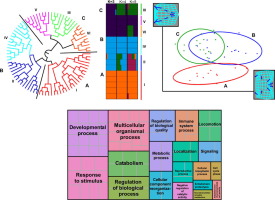当前位置:
X-MOL 学术
›
Mol. Phylogenet. Evol.
›
论文详情
Our official English website, www.x-mol.net, welcomes your feedback! (Note: you will need to create a separate account there.)
Local adaptation fuels cryptic speciation in terrestrial annelids.
Molecular Phylogenetics and Evolution ( IF 4.1 ) Pub Date : 2020-02-17 , DOI: 10.1016/j.ympev.2020.106767 Daniel Fernández Marchán 1 , Marta Novo 2 , Nuria Sánchez 2 , Jorge Domínguez 3 , Darío J Díaz Cosín 2 , Rosa Fernández 4
Molecular Phylogenetics and Evolution ( IF 4.1 ) Pub Date : 2020-02-17 , DOI: 10.1016/j.ympev.2020.106767 Daniel Fernández Marchán 1 , Marta Novo 2 , Nuria Sánchez 2 , Jorge Domínguez 3 , Darío J Díaz Cosín 2 , Rosa Fernández 4
Affiliation

|
Uncovering the genetic and evolutionary basis of cryptic speciation is a major focus of evolutionary biology. Next Generation Sequencing (NGS) allows the identification of genome-wide local adaptation signatures, but has rarely been applied to cryptic complexes - particularly in the soil milieu - as it is the case with integrative taxonomy. The earthworm genus Carpetania, comprising six previously suggested putative cryptic lineages, is a promising model to study the evolutionary phenomena shaping cryptic speciation in soil-dwelling lineages. Genotyping-By-Sequencing (GBS) was used to provide genome-wide information about genetic variability between 17 populations, and geometric morphometrics analyses of genital chaetae were performed to investigate unexplored cryptic morphological evolution. Genomic analyses revealed the existence of three cryptic species, with half of the previously-identified potential cryptic lineages clustering within them. Local adaptation was detected in more than 800 genes putatively involved in a plethora of biological functions (most notably reproduction, metabolism, immunological response and morphogenesis). Several genes with selection signatures showed shared mutations for each of the cryptic species, and genes under selection were enriched in functions related to regulation of transcription, including SNPs located in UTR regions. Finally, geometric morphometrics approaches partially confirmed the phylogenetic signal of relevant morphological characters such as genital chaetae. Our study therefore unveils that local adaptation and regulatory divergence are key evolutionary forces orchestrating genome evolution in soil fauna.
中文翻译:

局部适应助长了陆地类动物的神秘物种。
揭示隐性物种的遗传和进化基础是进化生物学的主要重点。下一代测序(NGS)可以识别全基因组范围内的局部适应性特征,但很少用于隐密性复合物,尤其是在土壤环境中,因为综合分类法就是这种情况。Car属(Carpetania),由六个先前提出的推定隐性谱系组成,是一个有前途的模型,可用于研究塑造土居谱系中隐性物种形成的进化现象。使用基因分型测序(GBS)来提供有关17个种群之间遗传变异的全基因组信息,并对生殖器eta毛进行几何形态计量学分析,以研究未探索的隐秘形态演变。基因组分析揭示了三种隐性物种的存在,其中一半先前确定的潜在隐性谱系聚集在其中。在800多个基因中检测到了局部适应性,这些基因可能参与了多种生物学功能(最著名的是繁殖,代谢,免疫应答和形态发生)。几个具有选择特征的基因显示出每个隐性物种共有的突变,处于选择状态的基因在与转录调控相关的功能(包括位于UTR区域的SNP)中富集了很多。最后,几何形态计量学方法部分地证实了相关形态特征(例如生殖器壳)的系统发育信号。
更新日期:2020-02-20
中文翻译:

局部适应助长了陆地类动物的神秘物种。
揭示隐性物种的遗传和进化基础是进化生物学的主要重点。下一代测序(NGS)可以识别全基因组范围内的局部适应性特征,但很少用于隐密性复合物,尤其是在土壤环境中,因为综合分类法就是这种情况。Car属(Carpetania),由六个先前提出的推定隐性谱系组成,是一个有前途的模型,可用于研究塑造土居谱系中隐性物种形成的进化现象。使用基因分型测序(GBS)来提供有关17个种群之间遗传变异的全基因组信息,并对生殖器eta毛进行几何形态计量学分析,以研究未探索的隐秘形态演变。基因组分析揭示了三种隐性物种的存在,其中一半先前确定的潜在隐性谱系聚集在其中。在800多个基因中检测到了局部适应性,这些基因可能参与了多种生物学功能(最著名的是繁殖,代谢,免疫应答和形态发生)。几个具有选择特征的基因显示出每个隐性物种共有的突变,处于选择状态的基因在与转录调控相关的功能(包括位于UTR区域的SNP)中富集了很多。最后,几何形态计量学方法部分地证实了相关形态特征(例如生殖器壳)的系统发育信号。



























 京公网安备 11010802027423号
京公网安备 11010802027423号